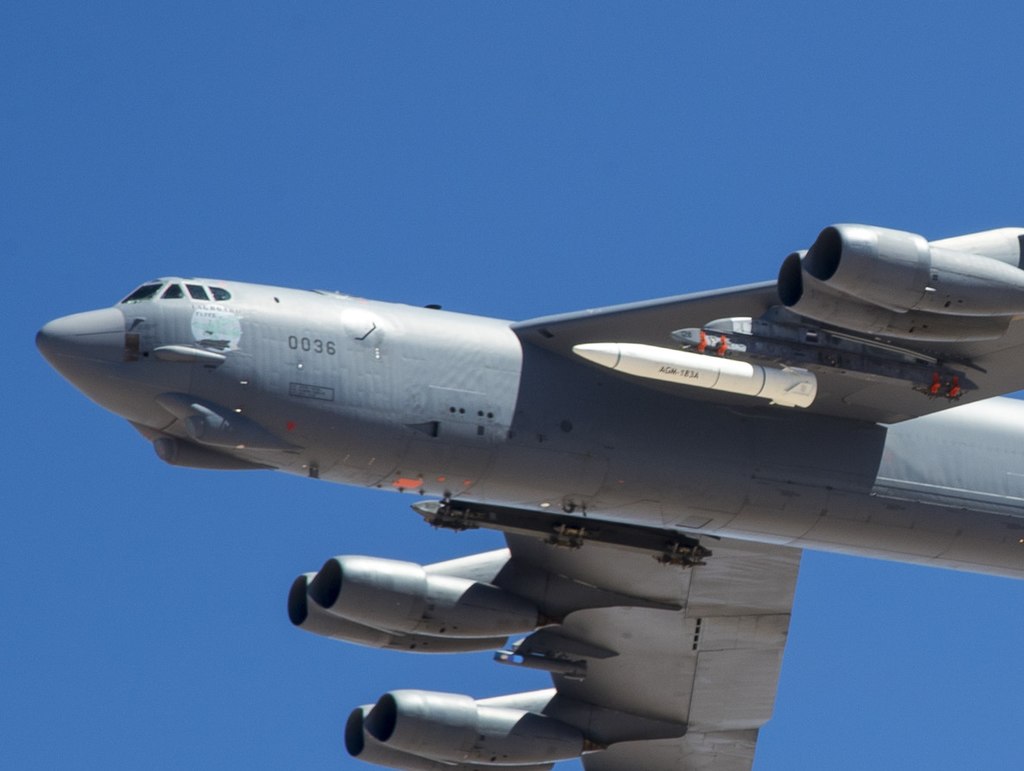In a first-of-its-kind exercise, the US Air Force will test-fire its hypersonic missile, AGM-183A, from a B-52 bomber sometime in the next few weeks, according to reports. Earlier, the aircraft had carried out a test flight with the missile.
The missile, officially called Air-launched Rapid Response Weapon (ARRW), was transported to the Edwards Air Force Base, California on March 1 and the ground tests began for the flight certifications, the Air Force said.
The AGM-183A is believed to be the first hypersonic weapon in the US arsenal, according to space.com portal.
During the air-borne test, ARRW would be mounted under the B-52 Stratofortress bomber. Earlier captive carry tests have shown the bomber carrying the missile under the left-wing pylon.
“The BTF-1[Booster Test Flight-1] test vehicle is complete and is progressing through ground testing to verify its readiness for flight. The team has successfully dealt with COVID challenges and resolved technical findings not uncommon in a first-of-a-kind weapon system,” Brig. Gen. Heath Collins, Air Force Program Executive Officer for Weapons said earlier this month.

“We have minimized schedule delays while maintaining a laser focus on engineering rigor. Our first BTF will happen in the next 30 days, followed by several additional boosters and all-up-round test flights by the end of the year,” he added.
The ARRW is a hypersonic boost-glide weapon developed by the American aerospace and defense company Lockheed Martin, in collaboration with the US Air Force.
The weapon can move at a speed beyond the hypersonic threshold of Mach 5, or fives the speed of sound. Some experts say it can reach a speed of up to Mach 20. The weapon is perhaps the one, which former US President Donald Trump had referred to as a “super-duper missile which is 17 times faster than existing missiles in the United States arsenal”.
The upcoming test will help in the development of the booster test vehicle, which would achieve the necessary high speeds to deliver the ARRW glide vehicle and the payload to the designated targets. While the exact specifications are still unknown, experts believe the missile has a range of more than 1,000 miles.
Stating the essence of the test, the Air Force mentioned that the BTF-1 will demonstrate the booster’s ability to reach operational speeds and collect other important data. In addition to booster performance, the test vehicle will also “validate safe separation and controllability of the missile away from the carrier B-52H, through ignition and boost phase, all the way up to separation of a simulated glide vehicle”.
“The simulated glider will not sustain flight, and will safely disintegrate soon after separation. The 412th Test Wing will conduct the ARRW BTF series over the Point Mugu Sea Range in California,” it said.
Why Hypersonic Weapons?
Currently, Russia and China have achieved success in developing hypersonic weapons, with the US closely trailing behind. India also tested its Hypersonic Technology Demonstrator Vehicle (HSTDV) last year, which achieved all its flight parameters.
There are two types of hypersonic weapons — hypersonic cruise missiles and hypersonic glide vehicles. Hypersonic weapons, by definition, travel five or more times the speed of sound.
Hypersonic cruise missiles, which are powered by scramjet, are restricted below 100,000 feet while hypersonic glide vehicles can travel higher. Compared to a ballistic (parabolic) trajectory, a hypersonic vehicle is capable of large-angle deviations from a parabolic trajectory.
The deadly weapons have the speed of a ballistic missile and the maneuverability of a cruise missile. They can maneuver between varying altitudes and azimuths, making them harder to detect.
Currently, there is hardly any air defense system in the world that can intercept hypersonic weapons.
Follow EurAsian Times on Google News




